#hotel adriatic
Explore tagged Tumblr posts
Text

The bay of dead hotels. Kupari. Croatia. Photo by S.N.
10 notes
·
View notes
Photo

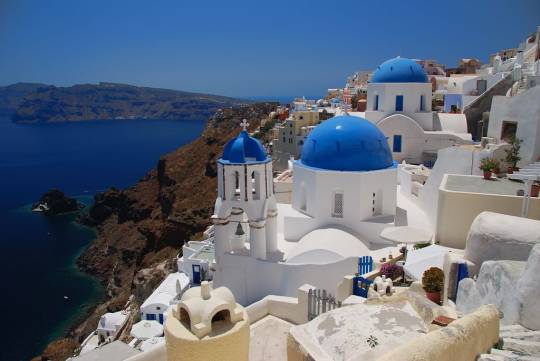


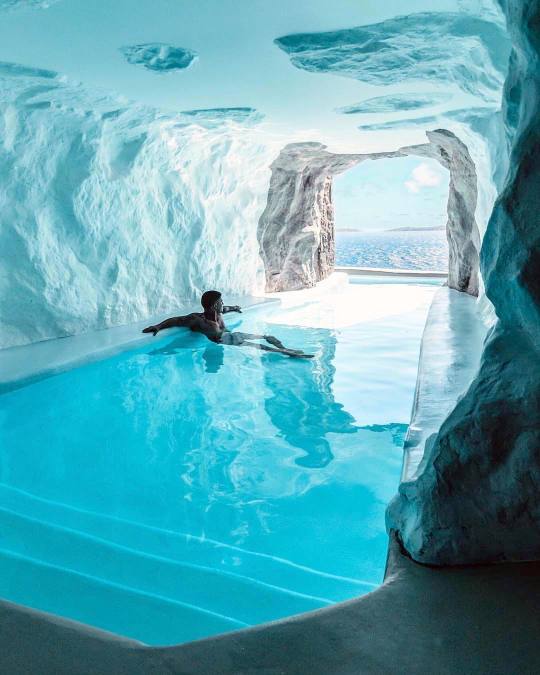
El hotel Cavo Tagoo seguro que vale lo que cueste. Las habitaciones con vistas al mar. Y las suite con la piscina de la cueva creo que pueden justificar cualquier cosa que quieran cobrar. El salón y el bar de la piscina tiene vistas panorámicas a Mykonos y a la isla de Delos. Tiene una piscina infinita con iluminación que cambia de color y terrazas de madera que parecen flotar en el agua. Tiene hasta médico de guardia, por lo del mal de Stendhal y eso...
#mykonos#luxury#hotel#5 starts#5 estrellas#lujo#mediterranean sea#mar mediterraneo#adriatic sea#mar adriatico#top#beauty#belleza#greece#grecia#wonder#maravilla
10 notes
·
View notes
Text

Grand Hotel
Rimini • L’Ostenda d’Italia
~ Mario Borgoni (Italian, 1869-1936), circa 1908
6 notes
·
View notes
Text
Nik dares to dream.
CW: none, a little suggestive at the end.
Price and Nik sit in Price's bunk in their boxers. It's a compromise; Nik's managed to get Price out of his office with only a single folder of paperwork and a half-chewed biro. Just one more form, Nik. It'll keep me ahead tomorrow.
It's a delicate operation, prying John Price out of his office and his clothes. To hang Captain Price on the coat hook for the night, to let John stretch his legs. Slowly, slowly.
Nik sits patiently at John's back, nosing the soft hairs at the base of his neck, savouring the awful cologne he insists on wearing while on base. He needed a better one, really, and Nik had spent half an hour in a 'John Lewis' pawing over scents a week or so ago. A very flowery woman had overwhelmed him with smelly strips of cardboard and jargon he didn't recognise, so that had been mission failed. He did consider asking Farah or Iskra for help, but... Eh, Nik could tolerate the musky shit.
John's hair is scruffy and Nik knows he only has about a day to enjoy it before John goes and gets it cut back into regulation tidiness. Soap has a nickname for it; short, back and slap? Or was it... short, slap and twat? Back and... hmm, Nik can't remember.
But he does know he prefers John like this.
Ruffled, unkempt, just as he looks when they're off grid; rough stubble, scruffy hair, sweat and gun oil, his blue eyes bright, wild. Alive. So confident, lethal, and... Hmm, now what did Ghost call it? Ballsy.
"Da."
"Hm?" John doesn't look up from his paperwork, chewed pen scratching away.
"Ahh, sorry. I was... hmm, mechta. To have dreams that are awake."
"Hm," John huffs softly, shoulders lifting in a half shrug, "a daydream."
"Daydream," Nik repeats, resting his nose against the back of John's neck. He decides he doesn't mind the bad cologne, or the loss of the scruffy hair; he can't have John naked and warm against him when they're in the field. Of course, Nik would be lying if he said he hadn't fantasised about sex in his helicopter. Maybe, one day...
Nik moves over to John's shoulders and spends some time admiring another favourite thing. Something he can only enjoy in these moments when the world is locked out, and danger is a million miles away.
The freckles.
When he'd been a boy, his grandmother had likened them to kisses from angels, and Nik quite liked the idea that some were watching over John when he couldn't be, leaving their footprints on his skin beneath his Kevlar vest. He shifts closer, runs the backs of his fingers down John's spine to settle his hand at his waist, and noses those freckles with a contented hum.
He imagines John in the sun, perhaps on a beach in Croatia or Montenegro. Nik's always liked that part of the world; it lacked the touristy aftertaste of the coastal towns in the Mediterranean, and maintained some of its unique character. They could take a boat out to the sunken wrecks in search of ancient pottery and glass, swim in the Adriatic with the reef sharks and turtles, visit the museum full of maritime weaponry and stories of pirates, and each day John's skin would sprout more freckles for Nik to kiss.
He kisses them now. Languid, lingering. His thumbs stroke in circles, and Nik closes his eyes with the taste of John's skin in his mouth. They would drink good beer, smoke good cigars, sit together at the end of the pier in Dubrovnik perhaps and watch the lights twinkle on the surface of the ocean, John's hair would be ruffled and soft with sun and sea salt. He'd laugh, relaxed and unbothered, no paperwork. Half cut, they would stagger back to their hotel, and Nik would--
"Nik."
Nik blinks. He can see the side of John's face where he's turned to look over his shoulder. There's a hand over his at John's waist, goosebumps over John's shoulders and down his biceps. The biro sits forgotten on the manilla folder.
"Da."
"You were holdin' tight. Want to tell me about these daydreams?"
Nik feels his ears warm, and perhaps his sheepish response gives John the wrong idea. "One day they might not be dreams. I will keep them as a surprise."
"You dirty bastard..."
"They were not dirty! Eh, not all of them."
"Don't believe you, mate. Too much filth for you to even tell me about. Shocking."
"Chtob u tebya hui vo lbu vyros, Price! Your mind is in the gutter."
Nik grabs John around the middle and pulls him back into a tight embrace. He tries to gain the upper hand with a grapple, but John takes up the challenge and they tussle for some minutes, giggling and guffawing like schoolboys. The folder and pen scatter onto the floor, along with the blankets and a pillow.
Nik gains the upper hand through sheer bulk, and because he's not afraid to play dirty and grab at John's underarms, making him bunch up and wriggle in surrender. Still far too honourable in the bedroom. They settle into a kiss, Nik's arm curled beneath John's head to keep it tucked close, one of John's legs trapped in his. He slides a hand down the curve of John's body and into his boxers.
The first gasps are always the sweetest; John's always so surprised by pleasure, sometimes tries to cling onto the gruff, abrasive masculinity he uses as a shield from the world, but Nik knows how to handle him, how to coax him open. His body relaxes, his legs spread and he buries his hand in Nik's hair, chasing kisses and touches like a man starved.
One day, Nik promises himself, he will have John like this every night and in the morning he will not have to rebuild his walls again. One day. Hm. A man can dream.
98 notes
·
View notes
Text
last week I was swimming in the adriatic sea thinking about devil's minion and then telling myself how pathetic I am for thinking about devil's minion when literally this is my view

today i watched the first episode of hotel portofino and was like heyyyyy the setting looks really familiar, turns out it was filmed in croatia, so assad zaman may have also been swimming in the adriatic sea thinking about devil's minion and that makes me feel a little better 🖤
#hotel portofino#assad zaman#post for the niche group of people who go crazy when they find out their current fav actor was once at the same place they werw#shaking crying throwing up in fact#devil's minion#armand#daniel molloy#iwtv#interview with the vampire#im probably gonna delete this post later i just needed to get it out of my system#assad is so pretty can we get him in a movie#or like. a billion movies that are actually good#and also another 30 billion tv shows#please.#imma go read devils minion on ao3 now
47 notes
·
View notes
Note
I noticed there are dates on your top liners list, ranging from the 1870s to the 2000's. I think on my alt you told me it was one of the last made, and the last in current use (as a hotel [and apparently haunted house according to the third video?]).
Anyway, I was wondering if you had an overview on the history of Ocean Liner design and how they've changed over the years, both technical in terms of operation, and aesthetic from the point of view both as a theoretical passenger and a learned liner enthusiast!
Plus any fun details about your examples would be nice as well.
Svjsvphsvpusvpusv okay. I am going to need to split this up into multiple posts, because I can not convey all this information with the 10 Pic limit. So periodically, check the reblogs of this post. I will periodically be adding more to it over time. Also, I'm not really citing any sources because this is mostly from memory, so there MAY be some mistakes. Also, I'm typing all this on my phone, so... please forgive the formatting, grammar, and spelling mistakes.
To begin, let's quickly discuss what an ocean liner is. An ocean liner is a ship you travel on to cross the ocean. It's called a liner because it goes in a line across the ocean. In this sense, “cruise liners” don't really exist. The proper term is cruise ship. Many people mistake liners for cruise ships and vice versa, but they are different in both function and design. As wikipedia puts it, “Though ocean liners share certain similarities with cruise ships, they must be able to travel between continents from point A to point B on a fixed schedule”. This means liners need to be both durable, and fast, something cruise ships are neither of. Cruise ships also almost never do trans-Atlantic crossings unless absolutely necessary. They just aren't built to handle the Atlantic at its worst. Cruise ships usually stay relatively close to land and reschedule for bad weather. For example, the only liner still in service is the RMS Queen Mary 2, built in 2004. Her construction used 60% more steel than a cruise ship of the same size. She also has a top speed of about 30 knots, whereas a cruise ship never really needs to exceed about 18. So, to summarize, an ocean liner is a ship you use to cross the ocean. A cruise ship, while it may take you to numerous excursions, is essentially the destination itself, and it will return you to where you started once the voyage is over. Last thing before we start, GRT. Gross Registered Tonnage is essentially a measure of the total usable internal volume of a ship. Generally, this is a much better measure of the size of a ship than length. For example, the RMS Adriatic was 729 ft long. The Titanic was 882 feet long. Only 150 feet longer, no big difference, right? WRONG. The Adriatic was 25,000 GRT. Titanic was 46,000 GRT. Britannic, which was the same length as Titanic, but 2 feet wider, was 48,000 GRT. Nearly double the size of Adriatic, even though she's not much longer. The Lusitania was 787 feet, and she was 31,000 GRT. So even though Britannic was only about 12% longer, she was about 55% bigger. Last thing, a knot is a unit of speed 1 knot is 1.150779 miles per hour, or 1.852 kilometers per hour.
Anyway, now that we have that sorted out, let's get into the history >:3
So, it starts with the steam engine. At the start of the 19th century, if you wanted to get from Europe to America (or vice Versa), you needed to book passage in a sailing ship. In just 4 short months, you can cross the ocean :D! Between extremely unsanitary conditions and the high chance of you not making it to your destination at all, something needed to change. There were some experiments with bolting steam engines to old sailing vessels, and these were very successful, but really only proofs of concept. Railway engineer Sir Isambard Kingdom Brunel realized that if ocean travel could work like the railway, travel between continents could be much more efficient and safe. With a sailing ship, you were dependent on the wind and weather, so your departure and arrival dates couldn't be predicted with any guarantee of certainty. With a steam engine, the ship could move at a consistent speed over a set distance, regardless of the conditions. Now, ocean travel was consistent, regimented, and much safer. All of these came together in 1838 with the launch of Brunel's SS Great Western, which crossed the Atlantic in 18 days, going at 8.66 knots. She was 1,700 Gross Registered Tons (GRT, a measure of internal volume) and 234 ft 11 in long (71.6 meters). She was the first ocean liner. Granted, she was essentially just a sailing ship with paddle wheels attached to a very rudimentary steam engine, she even Still had sails, and she had a hull made from oak, but she was the first commercial venture to bring passengers across the ocean on a regimented schedule. She was also the first purpose built liner.
Now, these very early years of ocean liners aren't really my specialty, so I'll cover some major events.
In 1839, Sir Samuel Cunard was awarded the first British transatlantic steamship mail contract, and in 1840, formed what would later be known as the Cunard Line, one of the most famous lines ever, And still around to this day.
In 1858, Sir Isambard Kingdom Brunel was back at it again with the SS Great Eastern. With this ship, Brunel set out to solve a problem: He wanted to make a ship big enough to carry enough coal to not need to stop and refuel on the voyage to Australia. The Great Eastern was the largest ship in the world by a WIDE margin. Before Great Eastern, the largest ship in the world was the SS Adriatic of the Colin's Line. She was 3,670 GRT, and 354 feet (108 meters) long. The Great Eastern was a whopping 18,915 GROSS REGISTERED TONS. 5.5 TIMES BIGGER! SHE WAS 692 FEET LONG. As wikipedia puts it, “Her length of 692 feet (211 m) was surpassed only in 1899 by the 705-foot (215 m) 17,274-gross-ton RMS Oceanic, her gross tonnage of 18,915 was only surpassed in 1901 by the 701-foot (214 m) 20,904-gross-ton RMS Celtic and her 4,000-passenger capacity was surpassed in 1913 by the 4,234-passenger SS Imperator.” IT IS WITH HONOR THAT I INTRODUCE YOU TO BRUNEL'S “GREAT BABE”, THE SS GREAT EASTERN.
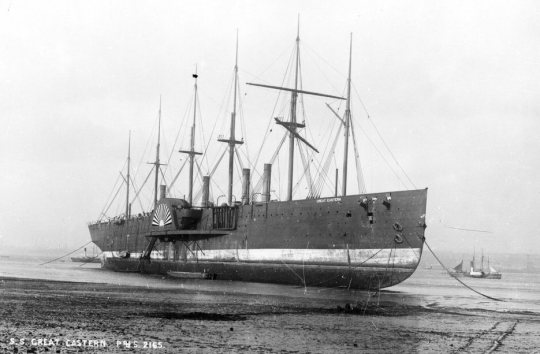
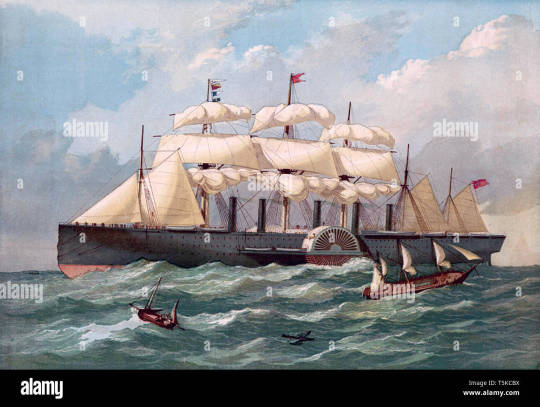
LOOK AT ‘ER! AIN'T SHE A BEAUT? IN A WORLD WHERE MOST SHIPS DIDN'T HAVE ANY FUNNELS, AND THE ONES THAT DID ONLY HAD ONE, THE GREAT EASTERN WAS THE ONE AND ONLY F I V E F U N N E L E D L I N E R. Even though she later lost one in an explosion, which was never replaced. She was rigorously mocked for her size and number of funnels, which is strange considering the 4 funneled superliner boom just 50 years later.
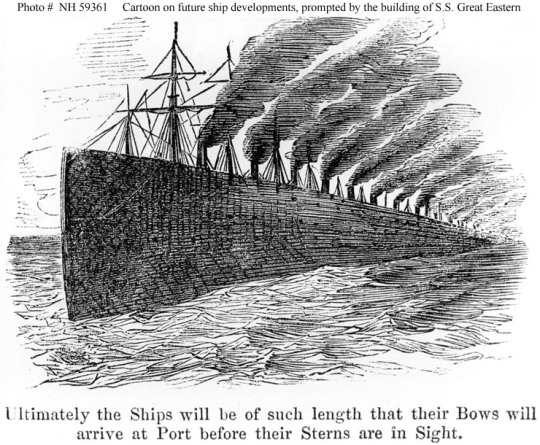
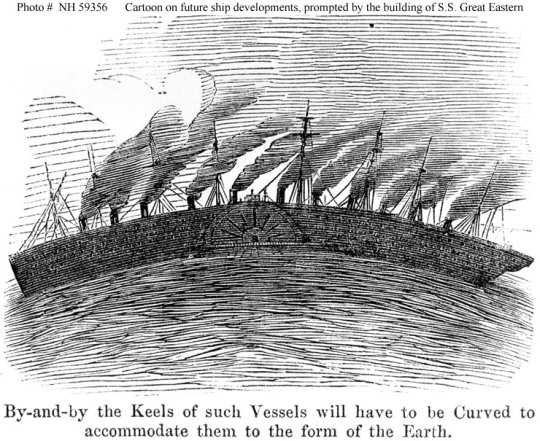
She FAMOUSLY didn't work, and the stress of trying to MAKE her work ended up sending Brunel to an early grave. SHE INDIRECTLY KILLED ONE OF THE GREATEST ENGINEERS OF ALL TIME! She then spent nearly a decade laid up as a glorified billboard:
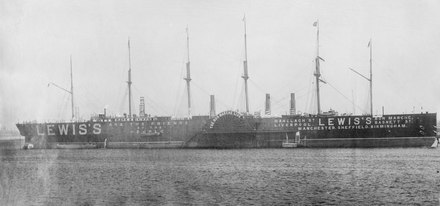
She damaged or sunk at least 10 ships in her short Career, had a penchant for spontaneously exploding (which is where her 5th funnel went), and when she was scrapped in 1890, all of her size records were still at least 9 years from being bested. She was NEVER profitable, and the DEFINITION of an outlier. Whenever discussing the largest ships in the world from 1848 to 1890, it goes without saying that the Great Eastern is not included. There is a REASON she's on my top 25, and I've only skimmed the surface. She was a hot mess, and I love her for it. I'd be happy to make a post entirely dedicated to her.
Next, we have the birth of the White Star Line. In 1870, they got their first ship: The SS Oceanic. (Not the RMS Oceanic of 1899 mentioned previously).
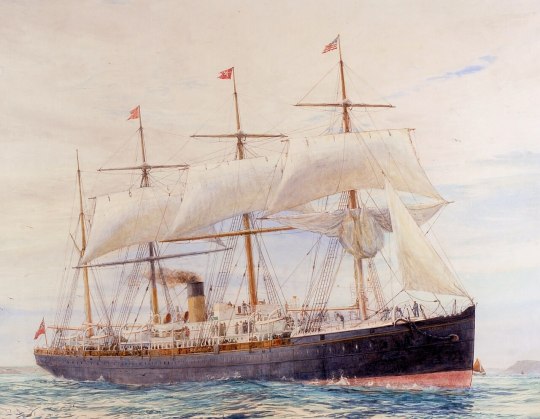
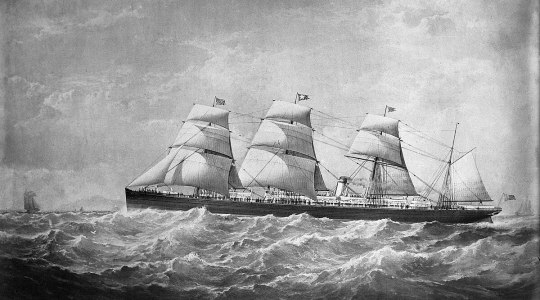
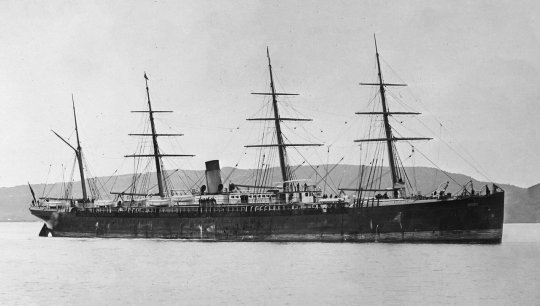
Many consider her and her 5 sisters to be the first “modern” liners, in the sense that they were starting to evolve past glorified sailing ships. She was 420 ft 4 in (128.12 meters) and 3,707 GRT. While her size PALED in comparison to the MIGHTY GREAT EASTERN, she was the “largest” ship in the world. Again, the great eastern kinda doesn't count. As modern as she was, Oceanic still had sails, and she had an INCREDIBLE top speed of… 14.5 knots. It was fast for the time. In fact, she won White Star Line their first Blue Riband for the fastest trans-Atlantic crossing. The ships of the Oceanic class were the Oceanic, Atlantic, Baltic, Republic, Adriatic (not the aforementioned RMS Adriatic, OR the SS Adriatic of the Colins Line), and Celtic. One of the big innovations of these ships was that they had a longer length to width ratio. Most sailing ships have a 6:1 ratio of length to width. The Oceanic class increased it to 9:1. With a thinner hull form, it reduced drag and allowed for a higher speed, albeit at the cost of stability. She was also one of the first ships at sea to use electricity. Not for lights, though. Those were still oil lamps. No, the electricity was for buttons in the cabins, which, when pressed, would summon a steward. Founder of the White Star Line, Thomas Ismay, realized that most of the profits of shipping lines came from The hundreds of steerage passengers, rather than the ultra wealthy first class/saloon Class passengers, so he made sure that he had THE BEST steerage accommodations by a scenic mile. He wanted to make sure that he'd be the one getting their business. Her steerage accommodations (3rd class) were fuckimg REVOLUTIONARY in their standards. In an era where poor people were treated like literal cattle, the steerage accommodations on the Oceanic class must have seemed like heaven on earth. Certainly better than anything they would have ever experienced on land. Steerage passengers had FRIGGIN PORTHOLES, which was a new thing for them because, like I said, before White Star, no one gave a shit about poor people. Also, for decks beneath the water line, there were skylights that reached all the way down to the bottom decks. The designers went through great pains to make sure everyone had fresh air and natural sunlight. Which, again, not something you'd find on other ships of the era, as basic as it seems. Anyway, the SS Atlantic, the White Star Line's second ever ship, was their first loss at sea. While we associate the line with Disaster today, history shows quite a different story. In their 65 years of operation, from 1870 to 1935, they operated at least 89 ships. They only lost 5 during peacetime disasters. This is a genuinely phenomenal track record, especially for the time. The aforementioned Collins Line lost literally 2/5ths of their ships (although they did have a much smaller fleet, so it's not an entirely fair comparison). Anyway, the SS Atlantic ran aground near Halifax Nova Scotia, with a loss of 535 people, leaving only 429 survivors. In the 30 minutes the ship took to fully sink, not a single lifeboat could be launched. I'd highly recommend Part-Time Explorer's videos on the subject.
In part 2, we'll cover from 1874 to 1900, with some of the most famous ships of all time. Like I said, this early stuff is where I'm weakest. Part 2 is where I'll become REALLY knowledgeable. >:3
#ss great eastern#great eastern#ss great western#great western#ocean liners#ocean liner#oceanliner#rms titanic#titanic#cunard#colins line#ss oceanic#ss atlantic#ss baltic#ss adriatic#ss republic#ss Celtic#oceanliners#rms oceanic#rms celtic#rms Adriatic#ss imperator
13 notes
·
View notes
Text
''Mr. Plant has owed me a shoe since July 5, 1971." - Chapter III - March 5th, 2024

Bari - Italy
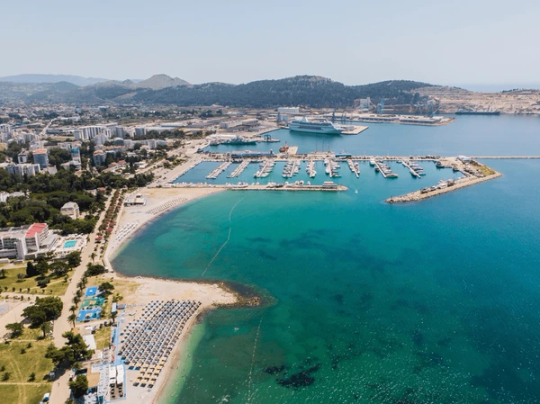
Bar - Montenegro
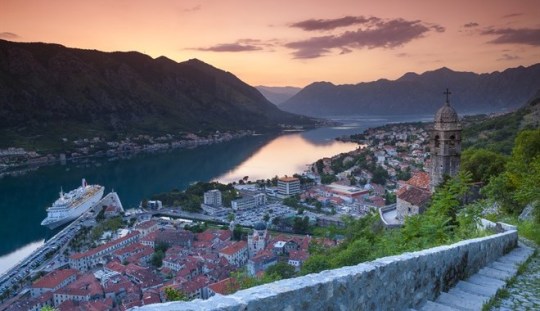
Kotor - Montenegro
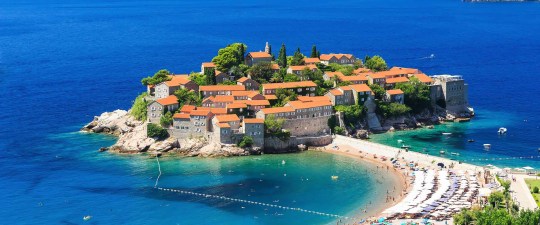
Sveti Stefan - Montenegro
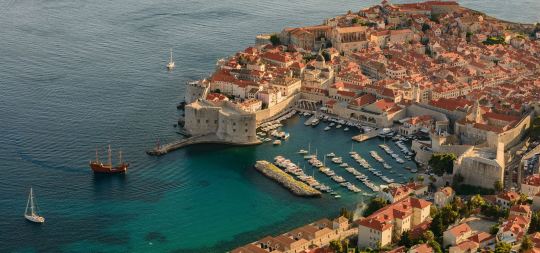
Dubrovnik - Croatia
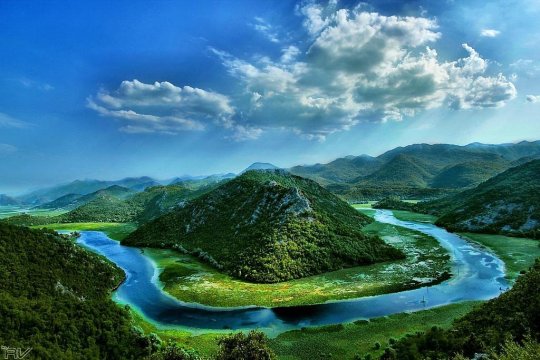
Lake Skadar - Montenegro.
BAR - MONTENEGRO- FORMER YUGOSLAVIA – October 1982
I returned from Saudi Arabia quite disappointed by the behavior of the Works Director, Eng. Birago. I liked the Taif hospital project, but I think the old Engineer had the whiskey affair tied to his finger, and at the first opportunity he got rid of me. I therefore responded with enthusiasm to the call from VOLANI, a company from Rovereto (Trento, Italy) specialized in industrialized architecture, essentially a direct competitor of FEAL Milan. I went to Rovereto for the interview with the Chief of Staff ''accompanied by Mother''! In the sense that my mother, as soon as she learned that I was going to Rovereto, immediately jumped on the car: beyond the desire to go around, it was one of her favorite destinations! The interview went well, and I was offered a job at their construction site in Bar, Montenegro, then still a territory of Yugoslavia. Before leaving for Bar, I wanted to spend a weekend in Madesimo, in Italian Alps. In 1981 there was no Internet, and therefore we had not booked the hotel. When we were in Medesimo we soon realized that the hotels were all closed (we learned that October/November are the months in which hoteliers go on holiday). In the end we turned to the local Carabinieri station, who suggested we go up to Alpe Motta where there was an alpine refuge that was definitely open.
JOURNEY TO BAR I had bought a new jacket, grey/blue on the outside, and with yellow padding on the inside. I took the flight to Bari, and then from Palese airport a taxi took me to the port. The ferry to Bar would leave in the evening. I enjoyed a single cabin, and the crossing of the Adriatic was uneventful. In the morning, when I tried to open the cabin door, I bumped into the bodies of those less fortunate than me, who had spent the night sleeping on the floor in the ship's corridor. We went ashore, and I noticed that I was surrounded by the usual dozens of women who at the time were shuttling between Italy and Yugoslavia, bringing all sorts of merchandise to their country. One of them, a middle-aged woman, asked me in in somewhat broken Italian:
Do you have something to declare?
No….
Well, it means that you will go through customs with these bottles of cognac, these shoes and these t-shirts on my behalf.
Ok…… Once we passed the customs control, the woman hurried to collect her goods, and she didn't even say thank you!!. I had made a first approach to the typical rudeness of Montenegrins; I would later have to experience other, even worse examples.
HOTEL SUTOMORE At the port exit there was the Site Manager waiting for me. A nice gentleman originally from Mantua: middle-aged, beard, open smile, had already been in Bar for several months with his wife and a few-month-old daughter in tow. He took me to the Hotel Sutomore, located in a village of a same name, a few kilometers north of Bar. The semi-deserted hotel given the season, a 9-storey building, was directly on the small but beautiful beach - the transparent sea reflected the sun of the afternoon that has just begun. It was lunch time, and after a shower, I went to the hotel restaurant, located on the mezzanine. Very large dining room, on Saturdays it was always occupied by receptions and weddings, with horseshoe tables, full of bottles of whiskey as per local custom. (Perhaps this is the reason why wedding dinners often resulted in furious arguments between relatives and friends?) I sat down in the half-empty room, took off my jacket and placed it on the back of the chair in front of me. The waiter, a young man around 20-22 years old, appeared out of nowhere, and without saying a word he took off his white jacket, took my jacket and put it on. -It's fine with me - he said, looking satisfied in the large window - how much do you want?
I looked at him astonished, with a mixture of surprise and anger and told him: it's not for sale, take it off immediately.
And he: but why not? Here all foreigners do this?!
''As well as? I said annoyed.
In the sense that they come wearing new things, sell them to us, and then leave again.
Well - I replied - I'm not "everyone" and I bought the jacket for myself - end of negotiation.
Oh well… if you say so….
What is there to eat? And here was the second unpleasant impact with another locals.
NIGHTCLUB Below the hotel there was a disco-dance hall. On Saturday evening it was packed, with a musical group that performed a Slavic variant of the rock songs popular in the 80s. The evenings inevitably ended in fights, to which alcohol, which was consumed in large quantities, made a substantial contribution. One evening I was at the entrance of the club, and an obviously drunk guy, with the help of a chair, demolished all the telephone booths positioned at the entrance of the club. I asked the girl at the checkout why no one called the police.
It's better not - she replied - things would take a worse turn - and in any case we know who he is, and the police will show up at his house around 5.00 am tomorrow, when he will be sleeping and will be unable to resist.
Ah… okay – I said.
OUR PROJECT The project consisted of the construction of a building for the Municipality of Bar, one to be use by the new Court, plus a school complex. Also included in the same contract were the rehabilitation of an analysis laboratory building in the hospital of Podgorica, 50 km inside Montenegro, as well as the capital of the state - The construction of a clinic in Ulcinj, 26 km south of Bar, the last city in Montenegro next to Albania border. In view of the supervision and some particular processes in which Italian labor was used, the bulk of the workers employed in the project were Yugoslavians. I noticed a detail that I remembered later, when the war broke out in Yugoslavia in the 1990s: carpenters, bricklayers, structure assemblers, were organized into ethnic groups (Slovenes – Serbs – Croats etc) and had no relationship between them. The construction time was from 7.00 in the morning to 2.00 in the afternoon - at 10.00 am there was a break, during which meals were consumed, sometimes cooked on site, with improvised barbecues. All the buildings were of a high standard, with continuous aluminum facades - the Bar complex stood out for a certain elegance, and the imprint of Italian design and materials immediately caught the eye.
THEFT ON CONSTRUCTION SITE Unfortunately the construction site had been the subject of a series of thefts, which essentially never stopped. An estimation made showed that the total value of the thefts amounted to the considerable sum of 870,000 USD. Several reports to the local authorities had brought only one result: one day we Italians were all summoned to the police station where they took our fingerprints. The Chief of Police told us that ''thieves don't exist in Yugoslavia, so it must be one of you who steals the materials''.
We had noticed - and photographed - that numbers of shacks buildings used as garages or warehouses had arisen in the vicinity of the construction site and beyond - all made with particular metal sheet that only VOLANI imported from Italy. One morning I arrived at the construction site very early, and I saw a man had loaded into a van some our anodized aluminum sheets - we used it as pillars cladding - I stopped him and asked him outright what he was doing: - Well – he replied – I saw these sheets of metal on the ground and I thought you didn't need them anymore.
Put them back where you found them – I told him
Okay… okay… no problem….
PODGORITZA Every now and then it happened that for work reasons I had to move to Podgoritza. The road first wound along the coast, and then inland, passing through Lake Skadar, the largest in the Balkan peninsula, which Montenegro shares with Albania. For lunch we used to stopp at a restaurant on the lake shore, where they served excellent fried carp. These gigantic fish were the result of cooperation between the then allies Albania and China: the Chinese had introduced millions of carp's fry into the lake, repopulating the waters which risked being left without fish. One morning we were going from Bar to Podgorica – me and a colleague of mine in two different cars. It was late November and very cold. It had rained during the night, and the morning frost had formed a thin film of ice on the road. Suddenly my colleague's car began a series of spins - I was following him closely, but luckily I managed to engage a low gear, and without touching the brakes I stopped on the edge of the road, also scraping the side of the Ritmo FIAT against the mountain rock that flanked the road. The colleague's car stopped in the middle of the road, with its nose facing against the direction of travel. I ran to help him get out of the car, just in time: another car arrived, the driver had lost control and crashed into my colleague's car! We realized that the situation had become very dangerous, and that we had to go to both sides of the road and try to signal the oncoming cars. Luckily the traffic was light at that time and we somehow managed to stop the traffic before anyone else ran into the two damaged cars. Then other drivers who arrived helped us to push the damaged cars towards a nearby dock. Once everything was over, and traffic was restored, the police arrived. First thing they asked me why we had moved the cars.
Because they were in the middle of the road, and represented a danger to other drivers – we replied.
No, said the policeman, you had to wait for our arrival, how can we do the investigations now?
Well, do as you like – my colleague told him.
But since the local police, when they meet a foreigner, always looked for every excuse to steal money, they gave us a report for having ''caused danger with dangerous driving''. And we had to pay immediately, otherwise the cars would be confiscated. So eventually we could leave that nightmare of wind and ice.
LIFE IN FORMER YOUGOSLAVIA IN '80. We stayed in Podgoritza for about two weeks, there was a need for a major overhaul in the work at the local hospital. Our Construction Manager had reached us and brought his family with him. His wife was desperately looking for diapers for her daughter, a rare commodity in Yugoslavia in 1982. Finally one day, through one of our local employees, the lady came into contact with a transporter who made frequent trips abroad and who had availability of otherwise unobtainable diapers. They met at a newsstand, generally in the early hours of the morning, and packs of diapers were wrapped in newspaper, so as not to arouse ''suspicions''. Annother day a colleague who had just returned from Italy told us that he had brought an 8 kilo bag of coffee. Unfortunately the coffee was in grains, therefore someone suggested to go to a small supermarket, where he had seen that there was a machine for grinding coffee near the cash registers. Very bad idea! While my colleague was inside the supermarket grinding the coffee, when by magic - perhaps attracted by word of mouth - dozens of local people showed up asking ''where is the coffee'…we heard that the coffee has arrived…'' The cashier said no that the coffee had not arrived (we learned that it had been missing from the supermarkets for some time) and that it had been brought by an Italian who had just arrived from Italy. But the crowd did not want believe it, and began to shout that it was ''the usual story of making the goods disappear and then selling them on the black market at increased prices''. My colleague, frightened by the crowd, didn't even finish grinding all the coffee and left the shop in a hurry, fearing for his own safety. In the meantime a couple of cars from the ''Milicija'' had arrived and quickly put an end to the uproar.
NOVEMBER 29TH - DAN REPUBLIKE PARTY
November 29th was a special day in the former Yugoslavia. Two important events in their history were celebrated: the second plenary session of the AVNOJ (Anti-fascist Council for People's Liberation of Yugoslavia) in 1943 and the first session of the Yugoslav Constituent Assembly in 1945. Propaganda via radio and TV had begun about ten days before , and it portrayed Germans and Italians as oppressors, occupiers of sacred Yugoslav soil, and responsible for countless war crimes. We had been instructed to keep a low profile, not leave the house or hotel in the evening, and to limit inspections on site as much as possible. Despite this, we suffered various provocations from the local authorities, until the day when a delegation from the Municipality of Bar held a remembrance ceremony inside the complex still under construction, where they had forced us to prepare a classroom complete with carpet and stage for the authorities. And so after having set up the classroom, the mayor gave a speech lasting almost two hours, during which he did nothing but insult Italy and Germany. The sovereignist and nationalist rhetoric still took root in a nation that would soon descend into a war which, as an Italian journalist said during the Yugoslav conflict ''was fought with the ferocity of ancient wars but with the lethal weapons of the era modern''.
A SAD STORY OF AN ITALIAN COLLEAGUE. There was this colleague, Adriano, a young man from Udine, who had been datinga beautiful local girl for some time. Adriano would be returning to Italy for a period of holidays, and was preparing for the return journey with his own car, with which he had reached Montenegro along the entire Adriatic coast. He asked his girlfriend's mother if he could take advantage of this trip to take her with him to Italy. Permission was granted, and on the morning of departure Adriano arrived early at the girl's house. At the honking of the horn the girl looked out from the balcony and urged Adriano to go up into the house. What happened a once the Italian boy entered the apartment it was never really clarified. From what we learned from Adriano it seems that his girlfriend's policeman brother had returned from Belgrade during that night, where he served. And had said he was against his sister's relationship with the Italian guy. The fact is that we were called around 10.00 am from the local emergency room, where Adriano had been admitted in a state of shock and with multiple fractures, especially in his face and upper limbs. A complaint was filed, but the local police, knowing who was involved in the beating, dropped the matter, classifying it as a ''Private Accident''. Adriano returned to Italy after 2 weeks in hospital, with an ambulance sent by VOLANI Rovereto.
WEEKEND's During weekends I always took the opportunity to visit the region around Bar. I have beautiful memories of Dubrovnik, a walled city built by the Venetians modeled on Venice but dry. Very beautiful and evocative is Svety Stefan, the islet connected to the coast where General Tito spent his holidays - Kotor, a picturesque fjord which during World War II was used to hide warships. Cavtat, a fishing town near Dubrovnik, where you could enjoy excellent fish and local wine. I also visited Cetinje, little more than a mountain town, birth placeof ''Jelena Petrović-Njegoš, princess of Montenegro, and then Queen of Italy'' following her marriage to Vittorio Emanuele III, King of Italy. At the time, Montenegro and Croatia showed great potential for tourism development, even if heavily penalized by the socialist system. In essence, the reception was modest, the infrastructure was missing or insufficient. With liberalization - and the arrival of the large international hotel chains - I believe that these shortcomings have been filled.
END of 1982 - ABANDONMENT OF THE PROJECT At the end of 1982, VOLANI decided to abandon the project in Montenegro, given the continuous thefts on the construction site, and the lack of payments by the Yugoslav Government. All Italians returned safely home for Xmas & New Year Holidays. I board a flight of then JAT Yugoslav Airlines, which reached Milan' Linate airport after a stop over in Sarajevo.
VISIT TO BAR IN 1984 In August 1984, on the way to a holiday in Greece, I did made a detour to see what had become of the Bar complex. Arriving near the former construction site, I found a disastrous situation: the project had been abandoned unfinished, the local population had wreaked havoc, stealing and dismantling everything they could. The unkempt grass reached up to the first of the 4 floors of what should have been the new town hall. Broken glass, false ceilings, doors, blown out windows, everything was in a state of abandonment. A disconcerting and somewhat incomprehensible vision. I didn't understand the reason why the local administration hadn't finished the project and taken the buildings into use, given that it was so close to finishing them.
11 notes
·
View notes
Text

First steps are taken
We have tickets to Rome purchased. The first hotel booked. Tickets for Vatican museums booked.
Next steps: determine exactly how long we need in Tuscany, Florence, Ravenna, and the Adriatic coast. Make bookings accordingly.
16 notes
·
View notes
Text










The bay of dead hotels. Kupari. Croatia. Photos by S.N. & C.N.
7 notes
·
View notes
Text
Discover the Beaches in Venice: Unveiling Hidden Gems Along the Adriatic Coast

Venice, renowned for its picturesque canals and historic landmarks, also offers a stunning coastline dotted with beautiful beaches. In this guide, we'll take you on a journey to discover the best beaches in Venice, from iconic stretches of sand to secluded coves awaiting your exploration.
Embracing the Coastal Beauty of Venice
Venice's beaches are as diverse as the city itself, offering something for every beachgoer, whether you seek relaxation, adventure, or cultural immersion. Join us as we delve into the enchanting world of Venice's coastal paradise.
Planning Your Beach Adventure: Tips and Recommendations
Before you set out to explore the beaches in Venice, it's essential to plan your adventure carefully. Here are some tips and recommendations to help you make the most of your beach getaway:
Choosing the Right Beach for You
With numerous beaches to choose from, it's essential to find the one that best suits your preferences. Whether you prefer lively atmospheres or tranquil seclusion, there's a beach in Venice for everyone.
Exploring Venice's Iconic Beaches
Venice is home to several iconic beaches, each with its own unique charm and appeal. Let's take a closer look at some of the must-visit beaches in Venice:
Lido Beach: Venice's Most Famous Stretch of Sand

Stretching for miles along the Adriatic coast, Lido Beach is Venice's most famous seaside destination. With its golden sands, shallow waters, and vibrant atmosphere, Lido Beach offers the perfect setting for sunbathing, swimming, and beachside dining.
Jesolo Beach: A Haven for Sunseekers and Water Sports Enthusiasts

Located just a short distance from Venice, Jesolo Beach is a popular destination for sunseekers and water sports enthusiasts alike. With its wide expanse of sand, crystal-clear waters, and array of amenities, Jesolo Beach is the ideal spot for a day of fun in the sun.
Discovering Hidden Gems: Secluded Beaches and Secret Coves
While Venice's iconic beaches draw crowds of visitors each year, the city is also home to hidden gems waiting to be discovered. Venture off the beaten path to uncover secluded beaches, quiet coves, and untouched natural beauty.
San Nicolò Beach: A Tranquil Retreat Away from the Crowds
Tucked away on the island of Lido, San Nicolò Beach offers a tranquil retreat from the hustle and bustle of Venice's more popular beaches. With its peaceful atmosphere, pristine sands, and stunning views of the Adriatic Sea, San Nicolò Beach is a hidden gem waiting to be explored.
FAQs: Answering Your Burning Questions
How do I get to the beaches in Venice?
To reach Venice's beaches, you can take a vaporetto (water bus) from the city center to Lido or Jesolo. Alternatively, you can hire a water taxi or take a ferry from the mainland.
Are there facilities available at the beaches?
Yes, most beaches in Venice offer amenities such as restrooms, showers, beach chairs, and umbrellas for rent. You'll also find beachside cafes and restaurants serving refreshments and snacks.
Is it safe to swim at the beaches in Venice?
Yes, the waters along Venice's coastline are generally safe for swimming. However, it's essential to exercise caution and be mindful of any posted warnings or advisories.
Can I visit the beaches year-round?
While Venice's beaches are most popular during the summer months, they can be visited year-round. Each season offers its own unique charms, from spring wildflowers to autumn sunsets.
Are there any beachfront accommodations in Venice?
Yes, there are several hotels and resorts located along Venice's coastline, offering beachfront accommodations and stunning views of the Adriatic Sea.
What other activities can I enjoy at the beaches in Venice?
In addition to swimming and sunbathing, visitors can enjoy a variety of activities at Venice's beaches, including beach volleyball, water sports, and leisurely strolls along the shoreline.
Conclusion: Your Venice Beach Adventure Awaits
Thank you for joining us on this journey to discover the Beaches in Venice. Whether you're seeking relaxation, adventure, or cultural immersion, Venice's coastline offers endless opportunities for exploration and discovery. So pack your bags, grab your sunscreen, and get ready for an unforgettable beach getaway in Venice.
5 notes
·
View notes
Text
Italy with 30some people was crazy. Especially since half of them (or so) were 16 or less.
We stayed in this little resort town near Venice, called Jesolo. It was an Italian Myrtle Beach. It also managed to have this one sketchy pizza place. It was mediocre. Anyway, the hotel we stayed in was beachfront, facing the Adriatic Sea. It was beautiful.
Until people started happening.
One night, people got a little too tipsy, more of hammered. And from that night on, there was a theory/rumor floating around our group that some people went skinny dipping.
I once talked to someone who went on the trip, and he disproved it, but that doesn’t change the fact that for a time, I thought it happened.
2 notes
·
View notes
Text
To the East! Day 1&2 - from Milan to Puglia
It's time to go visit the easternmost train station in Italy, the last one!
Since Italy is really slanted the easternmost station is also pretty far south, so I decided to leave immediately after work, go as far south as I could in one afternoon, and then cover the rest of the distance on Saturday. I'm once again using regional trains with the 3 days train pass, so it's gonna take a lot of trains and a lot of time, but it's also gonna be pretty cheap.

So first train is Milano>Bologna (pretty chill, not too crowded; kind of a boring line that I've traveled a thousand times but it's a windy sunny day and you can see the mountains near lake Garda from Parma which is... impressive).
So many people in Bologna station! I don't have enough time to find something to eat ;_;
Train 2: Bologna>Ancona is packed (I thought the train started from Bologna but it actually came from Piacenza), I had to stand for about the first hour D: When the train gets to the coast is already dark, and I'm a little sad that I can't see the sea (the rail is SO CLOSE to the sea in this part!)
My hotel is literally on the other side of the road from the station XD very nice since it's kinda late and I'm very tired.

(view of the station from the entrance of my hotel that I took the next morning)
~~~
The train I'm supposed to take from Ancona leaves at 11:45, but checkout from the hotel is at 10:00, so I get on an earlier train shares the first half of the line with the one with Pescara, and stop somewhere along the line (Ancona is a big city, and the city center is quite far from the station - also I visited it last summer, and I might as well take a look at somewhere else!).
So train 3: Ancona>Ascoli Piceno (but not really).

(See what I meant? The sea is JUST THERE)
I decided to stop in Grottammare, mostly because I've never been there and the station is pretty close to the sea. The old town is up the hill and it looks very pretty, but I don't have much time so I just stay in the seaside area.

(It's almost November and I wish I brought a short sleeved t-shirt. Most things are closed because the season is over but actually it feels like mid September and the effect is jarring)

Train 4: Grottammare>Pescara is a bit fuller, and I end up in a backward facing seat with only half a window. It doesn't look that different than when I did this route in August, but it is a little greener, and the beaches that were covered in beach umbrellas are now properly visible.
I have a very short time in Pescara to change trains, no time at all to visit anything, but honestly I didn't like it that much last time so that's fine by me. From here I'm basically tracing back the journey I made on the first day of my third leg of the Grand Tour of Italy last summer: same stops, same trains, very different time of day.
Train 5: Pescara>Termoli. The sun is on the other side of the train now, and the sea is SO blue.

I have about an hour in Termoli before the next train, so I get something to eat later and go looking for an ice-cream in the center. In the entire corso there was not one gelateria open. I get that it's the end of October but... Really? No ice cream?
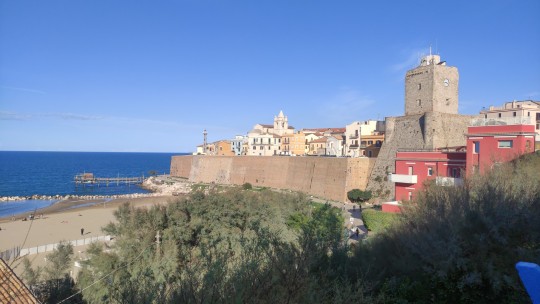
Train 6: Termoli>Foggia. The Molisan coast south of Termoli is one of the wildest, least "developed" in the entire Adriatic coast. Lots of pines, just very long stretches with no building in sight. Beautiful and interesting, compared to everything else (or maybe I should say - compared to what's north of it. Because now that I think about it Puglia also has similar coastlines I think).
And yes, it is not summer and it's SO CLEAR! All the green intermingled with the dark terrain it's just amazingly beautiful. If you want to visit Puglia autumn might be the best season (not if you want to swim in the sea though XD)

All I know about Foggia is that it's been mostly destroyed during WWII and rebuilt hastily, and it's considered one of the ugliest cities kn Puglia. Sadly the train station is quite far from the city center proper and I don't have a lot of time, so I only see the entrance of the Villa (the biggest municipal park) and a bit of a promenade.
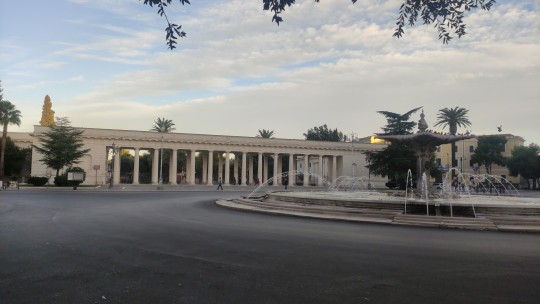

Train 7: Foggia to Bari. I'm starting to feel the travel fatigue. I'm ready to be at my destination, but I won't be there for at least another 3 hours probably more. Also it's dark, and the train is older and not very comfortable so meh. Train 7 morphs into train 8 when we get to Bari central station (of course the least comfortable train would be the one that I have to take twice XD). Just an hour, plus 10 minutes waiting for the bus, plus ten minutes on the bus and I'm finally at my uncle's house. It's been A Day. Can't wait to go to sleep XD
#yes i am finally free from school for 5 days so I'm going on another stupidly crazy 'adventure'#to the east!#travel#italy#my photography#mag travels from time to time#i just want a tag for the things i personally put out into the world
3 notes
·
View notes
Text
Wes Anderson on his new Roald Dahl film: ‘No one who is not the author should be modifying somebody else’s book’ – The Irish Times
Wes Anderson, the director of The Royal Tenenbaums and Asteroid City, has a celebrated eye for detail – right down to the choice of instruments for each score, according to the composer Alexandre Desplat, his regular collaborator.
The film-maker selected glockenspiel, triangles and other puppet-sized noisemakers for the percussion for Fantastic Mr Fox, and traditional taiko drums for the Japanese-set animation Isle of Dogs. When he made The Grand Budapest Hotel, he hung pictures of the characters, created by his partner, the costume designer Juman Malouf, around the hotel where the cast and crew were staying.
But even the best-laid plans can be meaningless when it comes to moviemaking, according to Anderson, who tells a story about The Darjeeling Limited, his Indian odyssey from 2007.
“You try to take control of it, but when you make a movie you’re saying, ‘I’m going to invite chaos into my life.’ When we made The Darjeeling Limited in India, we prepared everything very, very carefully. But it took us to strange places. We visited this little village, and we wanted to do a shot there and we needed a hut. And the elders of the village said, ‘We can build you the hut.’
“So we came back two weeks later and the hut was perfect, and we said, ‘Thank you very much. We’ll see you on Tuesday.’ And when we came back on Tuesday the hut had been decorated with all these flowers and swirls, and they painted it pink and blue. But the scene we wanted to shoot was a funeral.”
Anderson has certainly paid attention to detail today. We are at a hotel on the Venice Lido, during the city’s film festival, to hear about his new movie. When the director arrives he is wearing a tailored shirt the colour of the Adriatic Sea outside. Like the candy-coloured pinstriped suit he wore on the red carpet the day before, it’s a very Andersonian hue.

Dev Patel (left) as Dr Chatterjee, Ben Kingsley as Imdad Khan and Richard Ayoade as Dr Marshall in Roald Dahl's The Wonderful Story of Henry Sugar. Photograph: Netflix
The Wonderful Story of Henry Sugar, which stars Ben Kingsley, Benedict Cumberbatch, Ralph Fiennes and Dev Patel, is the first instalment of an anthology of Roald Dahl adaptations; three short films based on the short stories Ratcatcher, The Swan and Poison are in various stages of production.
“Henry Sugar is one of the friendlier ones,” Anderson says. “The others are the more familiar darkness of Dahl. Ratcatcher is very strange and a bit disturbing. I think The Swan is one of his best stories, and it’s extremely dark and quite brutal. Poison has an emotional brutality to it that’s pretty striking. It’s very early. We’re adapting stories that are from another time, with dated language. We’ve kept it how it is.”
This is not new terrain for Anderson – that big-screen interpretation of Fantastic Mr Fox dates back to 2009. He had been planning to adapt The Wonderful Story of Henry Sugar since a sojourn at Gipsy House, Dahl’s family home, in Buckinghamshire, some 20 years ago. The Dahl family, represented by Felicity Dahl and Dahl’s grandson Luke Kelly, set the rights to the story aside until Anderson could figure out a way to untangle the nested stories of his childhood favourite.
“I was planning this for a long time – years and years and years,” Anderson says. “I probably wouldn’t have done it except that I realised, reading the story to my daughter, that what I liked about the story is how Dahl tells it. I like his voice, his description, his metaphors and the way his words bring it to life. And I thought, well, maybe I can do that with a movie. That’s how I figured out that it had to be a short and that we had to use Dahl’s words.”

Benedict Cumberbatch as Henry Sugar in The Wonderful Story of Henry Sugar. Photograph: Netflix
That Fiennes, an Anderson regular, plays Dahl in a replica of the author’s study adds another layer to the mise en abyme of this 39-minute film. Its plot, or plots, run thus: the rich, idle man of the title (Cumberbatch) happens upon a journal detailing a guru (Kingsley) who can see without using his eyes. Sugar sets out to emulate that skill so that he might cheat at cards. Things do not go according to plan.
Following on from the stylised Asteroid City, the film swaps out scenery, casts actors (including Rupert Friend and Richard Ayoade) in multiple roles, plays with dollies and camera movement, and engages in Brechtian high jinks as Fiennes rattles through a slavishly faithful framing script.
“We loved making it,” Anderson says. “We loved working with Benedict Cumberbatch and the wonderful Ben Kingsley and Dev Patel and our old friend Ralph Fiennes. For this movie we needed actors who could take pages of text and bring them to life. Some actors are great at moments, but you would not ask them to go perform this play on stage. It’s not their thing. Their thing may be spontaneity, but it’s a different kind of work. English actors tend to be able to do everything. At the last play I watched in the West End, I sat down at the end to make a list of names on the playbill.”

Benedict Cumberbatch as Henry Sugar and Ben Kingsley as the croupier in The Wonderful Story of Henry Sugar. Photograph: Netflix
Anderson’s fidelity to Dahl’s text runs counter to the recent move by Dahl’s publishers to edit language gauged as offensive out of his work, a revisionism that Anderson has repeatedly denounced.
“I really don’t like it,” he says. “If I bought a painting – let’s say a Titian – and Titian called me up and said, ‘You know, I always thought there should be a little girl in the background of the painting; if I could just come over and fix that.’ I would say, ‘I’d rather you didn’t; this is my Titian.’ I feel that if somebody writes a book or somebody makes a film and it goes out into the world, then it’s ours. It’s too late to change it. And if I don’t believe that the artist or the author themselves can change his or her work, then the idea of somebody else changing it? I don’t even want to start that conversation. But, certainly, no one who is not the author should be modifying somebody else’s book.”
[ Yes, Roald Dahl sometimes got it wrong. But it isn’t up to us to make it right ]
That said, he has reservations about some of his own completed works, notably The Life Aquatic With Steve Zissou, a pretty failure that remains a source of disquiet for its creator.
“I’m a little bit obsessed with what I should have done differently,” Anderson says. “This goes to, like, the scheduling of the movie, the budgeting. It was a very, very big movie. It was very complex. It was the kind of movie where if you’ve made it once then you really know how to do it. We went 20 days over schedule. We went $10 million over budget. We struggled. I have got so many ideas about how we could have improved it in the cutting room. Maybe let’s just leave it at that.”
The layered storytelling of The Wonderful Story of Henry Sugar fits neatly with the director’s similarly complex recent features, notably The Grand Budapest Hotel, The French Dispatch and Asteroid City. That’s hardly accidental.
“I read it when I was probably eight years old, and it was doing a thing I had never seen before. There’s a story within a story. You meet a character and he says, ‘Let me tell you something,’ and then he tells a story inside of the story. I think my recent films all probably come from Henry Sugar in the first place.”
Anderson grew up in Houston, in Texas, the son of a writer and an archaeologist. He was a huge fan of Dahl and of the New Yorker film critic Pauline Kael. (He organised a private screening of his movie Rushmore for the critic on the eve of her retirement. Her response? “Did the people who gave you the money read the script?”) After graduating from the University of Texas he relocated to California, where he and his friend Owen Wilson wrote Bottle Rocket, which Anderson now describes as “the film that’s least like me”.
“I wanted to be like Spike Lee,” he says. “He’s one of the reasons why I became a film-maker. I was so inspired by She’s Gotta Have It. And I read his book Spike Lee’s Gotta Have It back in 1987. I tried my best to just follow his roadmap, which didn’t work at all. I didn’t even get into NYU. So I had to find another way.”

Wes Anderson not Spike Lee
His other way has brought together a regular troupe of actors and collaborators. Owen Wilson, his former roommate, has featured in seven films; Willem Dafoe, Anjelica Huston, Tilda Swinton, Edward Norton and Adrien Brody have appeared in five apiece. Desplat has composed every Anderson film since Fantastic Mr Fox. Robert Yeoman has served as director of photography for all of Anderson’s live-action films. Adam Stockhausen, his production designer, has been on board since Moonrise Kingdom, his 2012 film. These recurring credits coalesce into a recognisable style even though Anderson says he always believes he’s making something completely different from before.
“The idea of not doing things as they are normally done – you’ve got to find out how it’s normally done first,” Anderson says. “And that has happened over the course of making the movies. The best people to ask are the people I work with. People like Sanjay Sami, my key grip. He has expertise and irony. He has watched us deconstruct the way people make movies and find our own ways. And that’s fun.
“Each of the collaborations is so different. With casting it’s almost like a recipe: how are these people going to mix together? With Bob Yeoman the preparation is quite simple. We used to watch a lot of movies together before each movie, but now we’ve communicated about all these things so much, we have a well of shared references. He knows where I’m going. With Adam Stockhausen, we work mostly by email. We go scouting. The process tends not to be very preconceived. It’s a discovery process and research.”
In 2005 Anderson relocated from New York to Paris, where he has remained ever since. He loves being an American abroad, even if his French is not all that it could be.
“Until I was 23 years old my life was only in Texas. I had travelled a little bit in America. But the parameters of my life were compact. The people I knew lived in a small visible space. But I was always interested in movies. And movies were from everywhere. They were my way to get out and see the world. And the more I saw, the more I wanted to get out and see. I like the idea that having breakfast can be an adventure. And when you’re in a foreign country sometimes that’s exactly what it is. In Paris, just walking in a different neighbourhood is like going to the movies. I like the feeling of being a little bit outside of the place where I live.”
The Wonderful Story of Henry Sugar is on Netflix from Wednesday, September 27th
It's too bad that Wes Anderson feels the way he does about Life Aquatic. That's the only one I like. So weird! I was also studying Brazilian music at the time. Seu Jorge became a favorite.
2 notes
·
View notes
Text
The Best National Final of 1995

1995 was a poor year for the National Finals overall. There were a lot of ballads. Following on from Ireland's three wins with three ballads, there was an enormous amount of slow, low key crooning in a variety of languages. But among these conservative, restrained shows, there was one that went entirely in the opposite direction
Well done Dora 1995. HRT held their national final in the same venue as the previous two - the Crystal Ballroom of the Hotel Kvarner in Opatija on the Adriatic coast. A gorgeous venue full of invited guests in evening wear enjoying meals and drinks while being entertained by 20 acts vying to represent Croatia in Dublin.
What they got was a different direction. Lots of up-tempo pop, synths, choreography, updated folk numbers and very little in the way of a ballad. Some of it is not great, but it's such a contrast to everything else in 1995 and everything else that Croatia had done before. It truly is the antidote - even if the winner was...a ballad. Sung by a soprano no less.
Another country trying to challenge the orthodoxy was the UK - they appointed Jonathan King who immediate set about trying every musical genre in the UK pop charts. He even got at least two reasonably well-known names to try out (Londonbeat and Samantha Fox). In the end a rap song won very much a novelty.
Also good this year were Belgium (again for variety of music, but unfortunately they once again lose marks for not making easily watchable in 2023) and Cyprus.
Another trend this year is an across the board improvement in the quality of production of the finals as well as the quality of performance and songwriting. They may all be ballads, but they're notably of a higher standard than previous years.
The nadir of the national finals in 1995 is Evrovidenie. Even their jury said so. They refused to choose any of the finalist because none of them were of a quality sufficient to represent Russia at Eurovision - or at least that's what they said... The broadcaster had changed to ORT and gone was the anarchy of the previous year. Instead came some very stolid performances and the controversy of putting the third place act through to Eurovision without explanation. It must have left the Russian watcher feeling very cheated, not to mention the two acts that actually won.
#esc 1995#esc#eurovision#eurovision song contest#dublin#dublin 1995#national finals#dora 1995#a song for europe 1995#evrovidenie 1995
3 notes
·
View notes
Note
This is for the Modern AU: What if Ling Yi finally scored her breakout role but it required her to move and live for a few months in another country far from Olek? Like, he couldn't go with her. Would he travel to visit her sometimes? Would she, if there was time between shootings and promotional events? And what role do you think Ling Yi would star in for her first feature?
So if she got a part in a movie or a TV series, it might be filmed somewhere like LA or Toronto, but, yeah, it could easily be in a different country, which could present visa issues for a Polish immigrant like Olek. (Unless they were filming somewhere in the EU, which would make it a bit easier.) So let's imagine that she gets this breakout role and she's beyond excited (and of course Olek is so excited for her), but it's going to require her to spend four months in the UK or France or Hungary. It's going to be a lot of work and she knows she's going to be busy, but they still plan for him to fly over and visit her. Maybe he gets a week or two off from his job and goes to Poland first, seeing his family for a little while, and then flies to the country where she's filming. It probably wouldn't be a thing where he could visit on set, but there might be time for her to take the weekend away from shooting and then they go on a little mini-vacation to Paris or Budapest and see the sights and enjoy the room service at the hotel. (So romantic!) But I think during their time apart, they definitely would keep up with texting and video chats.
As for the role, I keep envisioning some kind of international spy thriller, like a Mission Impossible or Jason Bourne, only a ten-episode TV series rather than a movie. Ling Yi would be the girl at the center of it all, drawn into the danger and the mystery, probably ending up as the love interest of the male lead, but still remaining the beautiful and brilliant protagonist we were rooting for all along. (Does the last episode end with a shot of her sunbathing on the deck of a sailboat as it pilots through the blue waters of the Adriatic? How could it not?)
2 notes
·
View notes
Photo

Ancona (Marche). Views from the train station. Ancona (from the Greek Ankòn, elbow) coming from the west, it is not a city of passage, but I wanted to enter it for the first time (perhaps) and while waiting for the train I took a walk. The station is far from the historic center which extends over the hills, part of Mount Conero, which then degrade into the Adriatic. Between the center and the station is the port. The panorama of Ancona is characterized by the cathedral of San Ciriaco (996, Romanesque-Byzantine) on the top of the Guasco hill. Shots: a) Panorama between the wires of the station, in the background the Duomo is visible; b) the Flaminia street that leads to the port, on the left; c) Foresight: hotel building where I will stay in the future in the process of traveling to Greece. #shots #views #background #future #greece #hotel #process #stay #ancona #marche #trainstation #coming #waiting #adriaticsea #panorama #wire #lead #sight #travel #traveling #visiting #instatravel #travelling #tourism #instatraveling #travelgram #travelingram #massimopistis #sovVERSIvi #estremisti Information for the purchase of my new book "Extremists!": The book at a cost of 12.00 euros (120 pages), can be ordered in the bookstore (ISBN 978-88-591-5719-9 - Editore Aletti) or requested to the e-mail [email protected] with additional postage (currently 1.28 euros - fold of books). https://www.instagram.com/p/ClMXkg-Lsfy/?igshid=NGJjMDIxMWI=
#shots#views#background#future#greece#hotel#process#stay#ancona#marche#trainstation#coming#waiting#adriaticsea#panorama#wire#lead#sight#travel#traveling#visiting#instatravel#travelling#tourism#instatraveling#travelgram#travelingram#massimopistis#sovversivi#estremisti
2 notes
·
View notes